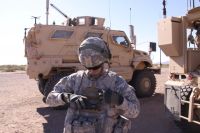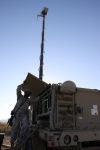WHITE SANDS MISSILE RANGE, N.M. — The Army has concluded its second Network Integration Evaluation, moving closer to deploying an integrated battlefield network after collecting valuable Soldier feedback on the latest tactical communications technologies.
 |
| Click to enlarge |
 |
| Click to enlarge |
The three-week event, known as Network Integration Evaluation, or NIE, 12.1, represented the first time that all of the components of the Army network to be fielded in fiscal year 2013 were united and evaluated in a realistic operational environment. Soldiers at the lowest echelons were brought into the network, communicating through text messages, digital photos and chat rooms.
Company commanders made quick decisions using information received in real time while moving around the battlefield. New hardware and software was integrated for the first time outside of a lab, and put to the test in mountainous desert terrain that mirrors the communications challenges in rugged places such as Afghanistan.
“We are getting a great look at connecting the Soldier to the network, and a fantastic look at mission command on the move — for the first time in an operational setting,” said Col. John Morrison, director of the Army G‑3/5/7 LandWarNet-Battle Command Directorate. “For the first time we’ve got everything talking together, so now we can establish an integrated network baseline. It’s just been phenomenal.”
The second in a series of semi-annual field exercises designed to rapidly integrate and mature the Army’s tactical network, NIE 12.1 involved 3,800 Soldiers of the 2nd Brigade, 1st Armored Division evaluating dozens of systems in operational scenarios. Soldier feedback and test results from the NIEs are directly shaping the makeup of the Army’s network Capability Set 13, which will begin fielding to up to eight brigade combat teams in fiscal year 2013.
Additional brigades will receive the latest network assets as part of Capability Set 14.
Those capability sets will include greater bandwidth to transmit voice, video and data across the battlefield, as well as the ability to bring situational awareness and mission command information down to the dismounted Soldier.
NIE 12.1 was also host to the Joint Tactical Radio System, or JTRS, Rifleman Radio program of record test. This radio, which is carried by platoon, squad and team-level Soldiers for voice communications, can connect with handheld devices to transmit text messages, GPS locations and other data. Soldiers with 2/1 AD also informally evaluated more than 45 other systems, including solutions proposed by industry to meet the Army’s identified network capability gaps.
“Getting information technology to the field in a rapid fashion is what we’re trying to do here,” said Col. Dan Hughes, the Army’s system of systems integration director. “Some of the systems that are here are systems that industry paid their money for, that they built, that they brought out, and are in the hands of Soldiers probably five to six years before they would be in the hands of Soldiers if we had gone through the regular (process). And they’re getting feedback immediately.”
That feedback, ranging from rave reviews to harsh criticism, will inform the Army’s decisions about what equipment to purchase and make part of the next capability set, as well as how some gear could be improved with certain changes.
That was the case with Nett Warrior, a Soldier-worn mission command system that 2/1 AD Soldiers deemed valuable but too bulky during the first NIE event. Those results informed Army leadership to revise the requirement, which resulted in a slimmed down version and a reduction of procurement costs for the device. This new version that leverages commercial technology debuted at this NIE and provided dismounted combat leaders with essential information, such as digital maps, text messaging and the GPS locations of friendly forces.
“With a radio you can tell them where you’re at, but with this they don’t even have to ask,” said Pfc. Philip Kerr, one of the Soldiers using Nett Warrior in mission threads here. “If there’s ever a situation where I’m down here and I can’t see the other side of a town, I can pop it up on a (digital) map. I can then see where everyone else is at, and that can be very valuable in case something goes wrong.”
The Nett Warrior devices connect to the network via the Rifleman Radio and its Soldier Radio Waveform. They run Joint Battle Command-Platform, or JBC‑P, software, the future version of the widely fielded Force XXI Battle Command Brigade and Below/Blue Force Tracking, known as FBCB2/BFT, system, which allows units to track friendly forces and exchange messages in order to synchronize operations and avoid fratricide. The software will host applications developed by the Army and third parties — similar to the “apps” marketplace used on the Apple iPhone or Google Android operating systems.
“We want to take the same capabilities that we have in our vehicles, in our command posts, in our aircraft, and provide them to the dismounted Soldier, specifically at the team leader through platoon leader level,” said Maj. Anthony Douglas, assistant product manager for Blue Force Tracking — Software. “Right now, Soldiers in Afghanistan are using (legacy) radios and hand and arm signals to communicate with each other.”
The current version of FBCB2, known as the Joint Capabilities Release, or JCR, for its interoperability with the Marine Corps, earned positive Soldier feedback for its new chat function. JCR Chat works like an online chat room within FBCB2, allowing users to instant-message in real time over the BFT 2 satellite network.
“It’s super easy to use — anybody that’s been on a chat room before knows how to use it,” Staff Sgt. Cody Moose said. “You can have multiple chat rooms, too. We use it for every mission.”
The Soldier input and system data collected during NIE 12.1 will be reviewed by a triad consisting of the Brigade Modernization Command, the Army Test and Evaluation Command and the System of Systems Integration Directorate under the Assistant Secretary of the Army for Acquisition, Logistics and Technology, or ASA(ALT).
The next event, known as NIE 12.2, will take place in the spring and further solidify the Capability Set 13 network. The six-week event will include the formal operational test for the Warfighter Information Network-Tactical, known as WIN‑T, Increment 2, the Army’s on-the-move, satellite-based communications network, which was informally evaluated at NIE 12.1.
WIN‑T Increment 2 is a major upgrade to the tactical network backbone that will extend satellite communications to the company level, allowing Soldiers to communicate seamlessly through voice, data, images and video — even in complex terrain that can break line-of-sight radio connections.
Source:
US Army

 von
von